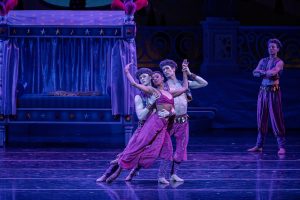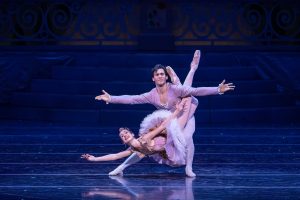REVIEW: Ballet outdoes itself with annual holiday classic
Dance is live theater, and thus every performance of a work of choreography differs from every other. Standard works evolve from year to year, as well: Since 2015, when Devon Carney introduced his version of The Nutcracker to Kansas City Ballet audiences, we have witnessed fine-tuning and often barely perceptible alterations that, to be sure, would be difficult to track unless you were examining videos of each year’s show.

The 2022 Nutcracker, which opened on December 7th at the Kauffman Center for the Performing Arts, was the most satisfying I can remember. This was partly, I believe, because Devon and his team have tidied, sculpted, and streamlined both the dance and the theatrical aspects of the show to its essentials. Though it still ran two hours and change, it felt somehow sleeker and at the same time more coherent.
Devon’s Act I Party Scene features less scurrying about and more actual dance than in some versions: After greeting the guests, Mother and Father (Whitney Huell and Andrew Vecseri on opening night) waste no time in leading a dozen of the adult visitors in a stately group variation: They are joined by pairs of young dancers who are integrated into the group in a manner that feels completely organic. The level of dancing by the youngsters (including Tess Gottschall as Clara and Lorenzo Guezuraga as Fritz at the opening) was exceptionally high.

The Kingdom of Snow scene was stunning: Chisel-jawed Gavin Abercrombie was regal as the King, offering velvet-like support to his dazzling Snow Queen (Sidney Haefs). Deftly synchronized Ice Crystals and Snow Flakes created kaleidoscopic patterns in the stage snow, as Sidney captivated the eye with one of the most commanding performances of the evening. The Kansas City Symphony performed Tchaikovsky’s peerless score live, led by Music Director Ramona Pansegrau.
Of course there is plenty of “camp” in Act I as well: The Dancing Bear drew considerable laughter, as did the antics of the adult Mice, who leapt out with a series of anachronistic dance steps as the clock struck midnight. (A Saturday Night Fever pose can draw laughter on any given night, but does it really fit into the aesthetic of a Romantic ballet?) The Battle is an immovable bit of physical comedy which is enhanced by Alain Vaës’ scenic designs (the Mice fight the Soldiers with oversized silverware, fountain pens, and such) and Holly Hynes’ witty costumes (hardly anyone can stifle an aww when the Baby Mice appear in their perfectly fitted furballs).
 On opening night, we were treated to something we’ve not experienced before. Devon, the company’s artistic director since 2013, played the role of Drosselmeier for the first time with this company, and with about as much wit and charm as I have ever seen brought to this most important role. He is one of four Drosselmeiers performing during the run, all of whom I’m sure will perform beautifully, but it was a privilege to see someone who, as it turns out, has been performing this role on various stages since the 1980s.
On opening night, we were treated to something we’ve not experienced before. Devon, the company’s artistic director since 2013, played the role of Drosselmeier for the first time with this company, and with about as much wit and charm as I have ever seen brought to this most important role. He is one of four Drosselmeiers performing during the run, all of whom I’m sure will perform beautifully, but it was a privilege to see someone who, as it turns out, has been performing this role on various stages since the 1980s.
Devon is a complete natural onstage, constantly in motion but never overly fussy. He moves with the grace of a true dancer (he was, after all, one of the finest principals in Boston Ballet’s history) and with the timing of a great comedian. After laboring to lift the life-sized Harlequin (Joshua Bodden), for instance, he grabbed his lower back, ever so subtly, as if to remind us with a wink that this was, remarkably, a sexagenarian we were watching!
Just as significant, this Drosselmeier ostensibly “stage directed” the action with elaborate arm motions: not only that of Act I but of parts of Act II as well. It was partly for the magical effect, but it also seemed oddly appropriate for the person who created this dance in the first place.

Act II remains a distinguished affair, with refined “national” dances that, for the most part, avoid ethnic clichés: Gone is the Chinese dragon, though Russian still contained standardized shouts and slaps that felt dated (which is not to say that folkloric dance does not still include this).
Whitney Huell was hauntingly torchy as the lead in Arabian, and Naomi Tanioka and Gabriel Lorena nearly stole Act II as enamored French Shepherds, completely convincing us that they were infatuated. Mother Ginger seemed to have a crook in her neck this year. Taryn Mejia was a heart-warming Rose in the Waltz of the Flowers, and the accompanying ensemble was treated with welcome restraint.
There are irresistible bonbons here, such as the miniature dancers who appear dressed as tiny versions of each variation to come. And though the “sundrenched” lighting of Spanish ended up looking more like a brownish-yellow haze, the rest of the Trad A Burns’ inimitable lighting design was spot-on.

Amanda DeVenuta was the charismatic Sugar Plum of the evening, with the firm support of Cameron Thomas. She broke down each detail, highlighting with remarkable technique the representational aspect of this number by allowing us to view its individual parts in all of their highly structured elements.
—By Paul Horsley
The Nutcracker continues through December 24th. For tickets call 816-931-8993 or go to kcballet.org.
To reach Paul Horsley, performing arts editor, send an email to paul@kcindependent.com or find him on Facebook (paul.horsley.501) or Twitter/Instagram (@phorsleycritic).
Features

In 2015, the Kansas City Ballet treated its production of The Nutcracker to a complete makeover, with new set designs by Alain Vaës, costumes by Holly Hynes, and lighting by…

If any musical is worthy to be performed by an opera company, it is The Sound of Music. Its best songs are not just Rodgers & Hammerstein at their most…

The double-bill of Pietro Mascagni’s Cavalleria rusticana (1890) and Ruggero Leoncavallo’s Pagliacci (1892) remains one of the most accessible evenings at the opera. With busy choruses, passionate arias and ensembles,…






